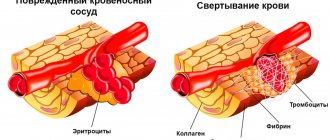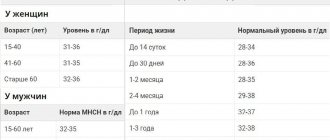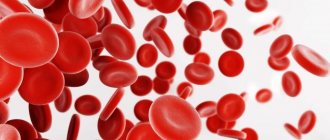The abbreviation ESR stands for “erythrocyte sedimentation rate,” measured in millimeters per hour. (In old reference books this analysis was called ROE). The research is based on a process caused by gravitational forces. Since red blood cells are heavier than other blood elements, they are the first to precipitate. Their counting in a vertically placed test tube after an hour is the basis of the analysis.
The speed at which red blood cells sink to the bottom depends on many factors, both physiological and pathological. ESR values differ depending on age and gender. Changes in indicators are possible due to dietary habits, the patient undergoing a course of treatment with certain types of medications, corticosteroids, and anti-inflammatory drugs.
Knowing what a high ESR indicates is especially important, since exceeding the standards most often indicates the development of a particular disease. High ESR numbers may indicate the presence of oncopathology, inflammatory process, infectious, rheumatological, or anemia in the body. The indicator will exceed the norm in case of myocardial infarction, trauma, allergies, pregnancy.
Despite the fact that ESR is a nonspecific indicator, the diagnostic value of the study is enormous. This is due to its high sensitivity. A change in this indicator is noted already in the early stages of the development of the pathological process, when other tests are not yet informative and remain normal. An increased ESR in a blood test is a reason to continue the examination and clarify the situation.
General information
New methods for diagnosing and determining the causes of diseases appear in modern medicine regularly. However, determining ESR in human blood is still an effective diagnostic method.
It is used for diagnostic purposes in both children and adults. Such a study is prescribed both when a patient who is concerned about a certain disease contacts a doctor, and during preventive examinations. Any doctor can interpret this test. ESR is included in the group of general blood tests (CBC). If this indicator is elevated, you need to determine the cause of this phenomenon.
Indications for research
A referral for ESR analysis is most often prescribed by a general practitioner. The analysis is carried out after acute viral and bacterial diseases to exclude the presence of complications.
Subspecialists can prescribe a referral for analysis:
- rheumatologist for joint pain; temperature, increased fatigue;
- surgeon for abscesses, suppuration, abdominal pain;
- nephrologist for problems with the urinary system;
- gynecologist for pain, pathological discharge;
- gastroenterologist for pain in the abdominal cavity, heaviness in the right hypochondrium, yellowing of the skin;
- endocrinologist for specific symptoms indicating metabolic disorders in the body;
- hematologist for a comprehensive examination of the hematopoietic process.
A referral for ESR testing is issued during planned hospitalization and surgical interventions. ESR is part of express tests during emergency operations.
What is ESR in the blood?
Those who are prescribed such a study are interested in why an ESR analysis is performed and what it is. So, the abbreviation ESR is the capital letters of the term “ erythrocyte sedimentation rate ”. Thus, using this test, the erythrocyte in the blood can be accurately determined.
Erythrocytes are, as you know, red blood cells. anticoagulants act on them over a certain period, they settle at the bottom of the capillary or test tube. The time during which a blood sample taken from a patient is divided into upper and lower layers is defined as ESR. It is assessed by the height plasma layer , which was obtained during the research process, in millimeters per 1 hour. The ESR indicator is nonspecific, however, it has high sensitivity.
If the ESR level in the blood is elevated, this may indicate the development of various disorders in the body. So, sometimes this is an indicator of the development of infectious, oncological, rheumatological and other pathologies even before the manifestation of obvious symptoms of diseases. Accordingly, if the ESR level is normal, the doctor, if necessary, prescribes other tests.
The ESR norm for women is 3 to 15 mm/h. But you need to take into account that this indicator also depends on age - normally it can be different for women under 30 and after 30 years. If necessary, the norm of red blood cells in the blood of women is also determined. In pregnant women, ESR increases starting from the fourth month. It should be taken into account that the ESR rate in pregnant women may vary depending on the period of gestation.
The norm for ESR in men is from 2 to 10 mm/h. A general blood test also determines red blood cells in the blood of men.
The normal ESR level in the blood of children depends on the age of the patient.
This value in the diagnostic process is important for:
- differentiation of diagnosis ( appendicitis and ectopic pregnancy , angina pectoris and myocardial infarction , rheumatoid arthritis and osteoarthritis , etc.);
- determining the body's response during the treatment of patients with tuberculosis , lymphogranulomatosis , rheumatoid arthritis , etc.;
- determining a disease that occurs latently (but it should be borne in mind that even normal ESR values do not exclude the development of a disease or neoplasm in the body).
Sometimes this concept is referred to as ROE . ROE in the blood and ESR are identical concepts. Speaking about ROE in the blood, we understand that this is an erythrocyte sedimentation reaction .
Once upon a time, this very concept was used in medicine, that is, the norm of ROE in the blood for women, the norm of ROE in the blood of children, etc. were determined. Currently, this concept is considered outdated, but any doctor understands what ROE is in a blood test, what ROE is in oncology, etc.
Diseases serving as an indicator for the study
Laboratory diagnosis of ROE indicators can be prescribed by the attending doctor in the presence or suspicion of the presence of such painful conditions:
- inflammatory or infectious processes;
- the presence of pathologies that are characterized by complications in the form of necrosis of tissue joints; medicine includes heart attacks, malignant tumors, purulent formations, tuberculosis, and intestinal diseases;
- connective tissue diseases such as rheumatism, arthritis, lupus, dermatitis;
- diseases that are based on metabolic and hormonal imbalances; the main diseases in this category that affect ROE are diabetes mellitus, increased or decreased production of hormones;
- anemic disease, significant blood loss and hemolysis are the primary sources of a decrease in the number of erythrocytes, and, accordingly, the cause of a decrease in ROE;
- nephrotic syndrome, which provokes the progression of liver disease;
- female changes in the body due to the menstrual cycle, menopausal changes, pregnancy or after childbirth;
- the period after surgery or surgical intervention are direct indicators for monitoring ROE values;
- measurement of ROE is indicated for increases in cholesterol;
- prolonged use of medications;
- intoxication of the body with life-threatening chemicals.
It is worth noting that for different diseases, the pattern of changes in ESR may vary depending on the stage of the disease, as well as the characteristics of its course. Only a specialist can competently interpret the picture of ESR variations, in accordance with additional examinations, patient complaints, and the clinical picture of the disease.
Diseases in which there is an increased ESR in the blood
If a patient has an elevated ESR in the blood, what this means is determined by the doctor during the diagnostic process. After all, this indicator is very important for diagnosis if the development of a certain disease is suspected. In the diagnostic process, a qualified doctor takes into account not only the fact that the patient has an increased value, but also determines what the presence of other symptoms indicates. But still this indicator is very important in many cases.
ESR: increased in diseases
An increased ESR in the blood of a child and an adult is observed if a bacterial infection - during the acute phase of a bacterial infection.
In this case, it does not matter where exactly the infections are localized: the picture of the peripheral blood will still reflect the inflammatory reaction.
viral infectious diseases occur . What specifically causes this indicator to increase is determined by the doctor during a comprehensive examination.
Thus, we are talking about the development of a certain pathological process if the ESR is higher than normal. What this means depends on the value of the indicator. Very high values – more than 100 mm/h – occur with the development of infectious diseases:
- for sinusitis , bronchitis , pneumonia , ARVI , colds , tuberculosis , influenza , etc.;
- for cystitis , pyelonephritis and other urinary tract infections ;
- for fungal infections , viral hepatitis ;
- in oncology (high rates can be observed for a long time).
During the development of an infectious disease, this value does not increase quickly; an increase is observed after 1-2 days. If the patient has recovered, the ESR will be slightly elevated for several more weeks or months. The reasons for a high ESR with normal leukocytes may indicate that the person has recently suffered a viral disease: that is, the leukocyte count has already returned to normal, but the red cell sedimentation rate has not yet.
The reasons for increased ESR in the blood in women may be associated with pregnancy, therefore, in the diagnostic process, the doctor must take into account these reasons for the increase in ESR in the blood in women.
An increase in ESR is a typical symptom in the following diseases:
- diseases of the biliary tract and liver;
- inflammatory diseases of a purulent and septic nature ( reactive arthritis , etc.);
- blood diseases ( sickle anemia , hemoglobinopathies , anisocytosis );
- ailments in which tissue destruction and necrosis ( stroke , heart attack , tuberculosis , malignant neoplasms);
- pathologies of the endocrine glands and metabolic disorders ( obesity , diabetes , cystic fibrosis , etc.);
- malignant degeneration of the bone marrow, in which red blood cells enter the blood that are not ready to perform direct functions ( myeloma , leukemia , lymphoma );
- autoimmune diseases ( scleroderma , lupus erythematosus , rheumatism , etc.);
- acute conditions in which the blood becomes more viscous ( diarrhea , bleeding , vomiting , postoperative conditions , etc.).
Bibliography
- Lugovskaya S.A., Dolgov V.V. Laboratory Hematology. Tver, Triad, 2006.
- Bottiger LE, Svedberg CA. Normal erythrocyte sedimentation rate and age. Br Med J 1967;2:85-7.
- Brigden M. The erythrocyte sedimentation rate: still a helpful test when used judiciously. Postgrad Med 1998;103:257-74.
- Saadeh C. The erythrocyte sedimentation rate: old and new clinical applications. South Med J 1998; 3:220-5.
- Sox HC Jr, Liang MH. The erythrocyte sedimentation rate: guidelines for rational use. Ann Intern Med 1986;104:515-23.
- Stuart J, Whicher JT. Tests for detecting and monitoring the acute phase response. Arch Dis Child 1988;63:115-7.
- Wolfe F, Michaud K. The clinical and research significance of the erythrocyte sedimentation rate. J Rheumatol 1994;21:1227-37.
Author:
Baktyshev Alexey Ilyich, General Practitioner (family doctor), Ultrasound Doctor, Chief Physician
Normal and pathological ESR values
In medicine, the physiological limits of this indicator are determined, which are the norm for certain groups of people. Normal and maximum values are shown in the table:
| In children (value depends on the age of the child) | Among women | In men |
|
|
|
ESR during pregnancy
If this value is increased during pregnancy , this is considered a normal condition. The normal ESR rate during pregnancy is up to 45 mm/h. With such values, the expectant mother does not need to be further examined and the development of pathology is not suspected.
Normal for women
The test is nonspecific and normal values are found in 95% of people. For an accurate diagnosis, it is used in conjunction with other indicators.
Roya's normal indicators are presented in the table:
| Age, years | Norm, mm/hour |
| Up to 13 | 43015 |
| Before 18 | 15-18 |
| Women | 42036 |
| After 50 | 15-20 |
According to sources of foreign literature, ROE is normal if it has indicators from 0-20 mm/hour. However, to accurately assess health, the doctor needs to know the woman’s age and the changes that occur in her body. If in children under 13 years of age the norm is a swarm indicator of 7-10, then during puberty it increases to 18 mm/hour.
In women, ROE should not exceed 15 mm/hour.
Sickle cell anemia ESR
Methods used to test ESR blood
Before deciphering what ESR means in a blood test, the doctor uses a certain method to determine this indicator. It should be noted that the results of different methods differ and are not comparable.
Before performing an ESR blood test, it must be taken into account that the obtained value depends on several factors. The general analysis must be carried out by a specialist - a laboratory employee, and only high-quality reagents are used. The analysis in children, women and men is carried out provided that the patient has not eaten food for at least 4 hours before the procedure.
What does the ESR value show in the analysis? First of all, the presence and intensity of inflammation in the body. Therefore, if there are abnormalities, patients are often prescribed a biochemical analysis. Indeed, for high-quality diagnostics it is often necessary to find out in what quantity a certain protein is present in the body.
ESR according to Westergren: what is it?
The described method for determining ESR - the Westergren method - currently meets the requirements of the International Committee for Standardization of Blood Studies. This technique is widely used in modern diagnostics. For such an analysis, venous blood is needed, which is mixed with sodium citrate . To measure ESR, the distance of the stand is measured, the measurement is taken from the upper limit of the plasma to the upper limit of the red blood cells that have settled. The measurement is carried out 1 hour after the components have been mixed.
It should be noted that if Westergren's ESR is elevated, this means that this result is more indicative for diagnosis, especially if the reaction is accelerated.
ESR according to Wintrob
The essence of the Wintrobe method is the study of undiluted blood that was mixed with an anticoagulant. The desired indicator can be interpreted using the scale of the tube in which the blood is located. However, this method has a significant drawback: if the reading is above 60 mm/h, the results may be unreliable due to the fact that the tube is clogged with settled red blood cells.
ESR according to Panchenkov
This method involves the study of capillary blood, which is diluted with sodium citrate - 4:1. Next, the blood is placed in a special capillary with 100 divisions for 1 hour. It should be noted that when using the Westergren and Panchenkov methods, the same results are obtained, but if the speed is increased, then the Westergren method shows higher values. Comparison of indicators is in the table below.
| According to Panchenkov (mm/h) | Westergren (mm/h) |
| 15 | 14 |
| 16 | 15 |
| 20 | 18 |
| 22 | 20 |
| 30 | 26 |
| 36 | 30 |
| 40 | 33 |
| 49 | 40 |
Currently, special automatic counters are also actively used to determine this indicator. To do this, the laboratory assistant no longer needs to dilute the blood manually and track the numbers.
Development plan
- Support for multimedia content (illustrations, videos)
- Support for third party ad networks via ADFOX
- Support for third-party analytics counters (Google Analytics, Mail.Ru, Rambler Top 100, Mediascope)
- Speed up loading Turbo pages by 4 times
- Tables, lists, quotes
- Image and photo galleries
- Displaying comments
- Embed codes for content from YouTube, Vimeo, Instagram, Twitter
- “Endless” feed (block “You may be interested in”)
- Site navigation
- Share button
- Additional advertising spaces
- Advanced analytics capabilities
- Ad rendering speed
- API for publishing content
- Call button, chats and feedback forms
- Support for content embed codes from VKontakte and Odnoklassniki
- Design customization in CSS
- Supports GIF animation and video players
- Editor for debugging Turbo pages
- Rating block
- Media content gallery with slider
- Quickly view a larger image by clicking
- Content block and anchor links
- Sidebar – new menu block
- Additional design types for the “You may be interested in” block
- Support for embedded content from Yandex.Maps and Yandex.Music
- Search form - on your website or with sending a request to search engines
- Impressions of new pages in Turbo format when following links from Turbo pages
- Product cards for online stores
- More statistics in Metrica and the ability to use goals
- Video in Turbo
- New page types
- Poll block
- Advertising optimization - new formats
- The ability to place a product on Turbo pages in one click so that the user does not leave the accelerated version of the store
- Custom blocks
- Authorization
- Possibility to leave a comment
- Advanced features of Metrica
- Feedback from webmasters
Expanded appearance customization options
We have started testing the display of elements created by site owners.
For example, Turbo pages can have complex interactive components using JavaScript, such as diagrams of the placement of chess pieces or players on the field. But there should be more tools that allow you to flexibly customize Turbo pages - and we, of course, will continue to add them. Please tell us what kind of customization is required for the Turbo pages of your website - leave your contacts in this form, and a specialist from the development team will contact you to clarify the details.New opportunities for online stores
Online payment and shopping cart will appear in the e-commerce arsenal. Moreover, in the Turbo version of the store you will be able to make purchases directly from the list of products, and after going to the cart, select delivery options. We will add the ability to pre-fill fields (for example, name or contacts) to the order form - if the site visitor is authorized in his Yandex account. It will become more convenient and easier for users to interact with the Turbo version of the store - there will be fewer failures and more conversions.
Advanced analytics in Yandex.Metrica
The Metrics Webvisor tool will help you analyze in detail the behavior of visitors to Turbo pages.
It records the actions of visitors on the site and shows them in video format - this way you can identify problems in navigation, logic and usability, and as a result, increase site conversion. Metrica will also feature new reports to analyze the effectiveness of the Turbo version of online stores.New blocks and widgets on Turbo pages
By the end of the year, Turbo pages will have:
a multi-level menu,- customizable dynamic forms,
- Apester platform embeds for surveys and quizzes,
- cards for grouping content on a page,
- possibility of fixing the site header,
- Scrolling support when viewing an image gallery,
- “Expand” button to view articles on the desktop,
- “breadcrumbs” to facilitate navigation on the site,
- opportunity to comment on articles.
And new widgets - including Market and Zen widgets
- will increase traffic and expand the site’s audience.
New advertising formats and optimization opportunities
- will appear with a parallax effect
, which will be placed under the site content. The content of such an ad unit appears from underneath the content as the user scrolls the page. The advertisement begins to appear smoothly from the bottom of the banner, and when scrolling, it gradually opens, after which it is just as smoothly and neatly hidden under the content.
Fixed horizontal sticky blocks.
for Turbo pages. This is a new tool for A/B testing of advertising designs with automatic selection of the most profitable option for each site visitor, which is currently undergoing closed beta testing. It will allow you to choose the optimal design of contextual advertising for a specific site.
on Turbo pages, we optimize advertising placements and other parameters so that auto placement brings you more income.
ESR in the blood: what do certain values mean?
As mentioned above, normal ESR values for a healthy man are considered to be 1, 2, 3, 4, 5, 6, 7, 8, 9, 10 mm per hour; for women, the normal value is from 2 to 15 mm/hour. Therefore, for women, a value of 12, 13, 14, 15 is considered normal. However, indicators for women in adulthood can normally be 16, 17, 18, 19, 20.
If the value exceeds the norm by several units, then the blood condition can be considered relatively normal. That is, an indicator of 21, 22 in a woman can be considered acceptable, as well as values of 23, 24 mm/h. When a woman is pregnant, this meaning is even greater. Therefore, expectant mothers have no reason to believe that a reading of 25 means something unpleasant. During pregnancy, the analysis may show 28, 29. ESR 30, 31, 32, 33, 34, 35, 36, 38 is also not evidence of the development of pathological processes in pregnant women.
This indicator increases with age. Therefore, if an ESR value of 40 is noted in elderly patients, the doctor determines what disease this is a symptom of and what it means by the accompanying signs. Normal values for older people are 43, 50, 52, 55 mm/h, etc. However, for young people, values of 40-60 mm/h are possibly evidence of serious disorders. Therefore, after receiving the analysis data, it is necessary to consult in detail about why the ESR is 60, what it could be, and undergo further research.
Low value
As a rule, the reasons for a low value of this indicator are associated with exhaustion of the body, weight loss, taking corticosteroids, hyperhydration, and muscle atrophy. Sometimes ESR is lowered in diseases of the heart and blood vessels.
Correspondence of ESR results obtained by Westergren and Panchenkov methods
| IN | P | IN | P | IN | P | IN | P |
| 1 | 1 | 31 | 27 | 61 | 48 | 91 | 66 |
| 2 | 2 | 32 | 27 | 62 | 49 | 92 | 67 |
| 3 | 3 | 33 | 28 | 63 | 49 | 93 | 67 |
| 4 | 4 | 34 | 29 | 64 | 50 | 94 | 68 |
| 5 | 5 | 35 | 30 | 65 | 50 | 95 | 68 |
| 6 | 6 | 36 | 30 | 66 | 51 | 96 | 69 |
| 7 | 7 | 37 | 31 | 67 | 52 | 97 | 69 |
| 8 | 8 | 38 | 32 | 68 | 52 | 98 | 70 |
| 9 | 9 | 39 | 33 | 69 | 53 | 99 | 70 |
| 10 | 10 | 40 | 33 | 70 | 54 | 100 | 71 |
| 11 | 11 | 41 | 34 | 71 | 54 | 101 | 71 |
| 12 | 12 | 42 | 35 | 72 | 55 | 102 | 72 |
| 13 | 13 | 43 | 36 | 73 | 55 | 103 | 72 |
| 14 | 14 | 44 | 36 | 74 | 56 | 104 | 73 |
| 15 | 14 | 45 | 37 | 75 | 57 | 105 | 73 |
| 16 | 15 | 46 | 38 | 76 | 57 | 106 | 74 |
| 17 | 16 | 47 | 38 | 77 | 58 | 107 | 74 |
| 18 | 17 | 48 | 39 | 78 | 59 | 108 | 75 |
| 19 | 17 | 49 | 40 | 79 | 59 | 109 | 75 |
| 20 | 18 | 50 | 40 | 80 | 60 | 110 | 76 |
| 21 | 19 | 51 | 41 | 81 | 60 | 111 | 76 |
| 22 | 20 | 52 | 42 | 82 | 61 | 112 | 77 |
| 23 | 21 | 53 | 43 | 83 | 61 | 113 | 77 |
| 24 | 21 | 54 | 43 | 84 | 62 | 114 | 78 |
| 25 | 22 | 55 | 44 | 85 | 63 | 115 | 78 |
| 26 | 23 | 56 | 45 | 86 | 63 | 116 | 79 |
| 27 | 24 | 57 | 45 | 87 | 64 | 117 | 79 |
| 28 | 24 | 58 | 46 | 88 | 64 | 118 | 80 |
| 29 | 25 | 59 | 47 | 89 | 65 | 119 | 80 |
| 30 | 26 | 60 | 47 | 90 | 65 | 120 | 81 |
Note: ESR results are presented in mm/hour; B - Westergren method; P - Panchenkov method.
What affects the ESR indicator?
In both women and men, the level of ESR is influenced by a number of different factors, both physiological and pathological. The key factors that most influence this analysis are identified:
- When determined by different methods - according to Westergren et al. - the norm of ESR in the blood of women is higher than that of men. So, an ESR of 25 in a woman may be normal. This is due to the physiological characteristics of blood in women.
- What is the normal ESR level in a woman’s blood depends on whether she is pregnant. For expectant mothers, the norm is from 20 to 45 mm/h.
- A higher ESR is observed in women who take contraceptives . Under this condition, a woman may have a normal ESR of 30. What this means, whether there is a pathology, or whether we are talking about a normal physiological indicator, must be determined by the doctor.
- In the morning, the rate at which red cells settle is higher than in the afternoon and evening, and differences in age do not matter here.
- Signs of accelerated sedimentation are observed when exposed to acute phase proteins.
- If inflammation and an infectious process develops, the values change a day later. how leukocytosis and hyperthermia . That is, on the first day of the disease the indicator can be 10, 14, 15 mm/h, and a day later it can increase to 17, 18, 20, 27, etc.
- ESR is elevated if there is a chronic source of inflammation in the body.
- A reduced value is observed with increased blood viscosity .
- A decrease in sedimentation rate occurs under the influence of anisocytes and spherocytes; the rate becomes greater under the influence of macrocytes.
Fictitious increase in indicators
An increase in the ROE coefficient beyond the limits based on age and gender does not always indicate the presence of pathology in the patient’s body. There are cases when elevated numbers are false indicators of illness. The following factors can provoke this result:
- the patient has varying degrees of obesity, unhealthy diet;
- elevated cholesterol levels, which can cause an increase in ESR;
- the patient is taking vitamin complexes or drugs of a medicinal group with a high content of vitamin A, as well as using oral contraceptives;
- recent vaccination against hepatitis;
- features of the female body;
- the presence of regular depressive and stressful overstrains.
The task of the attending doctor in such a situation is to correctly interpret the test results, and if there are doubts about the reliability of the data, send the person for re-analysis and prescribe auxiliary studies.
- ESR for arthrosis - All about joints
Elevated ESR in children
When the ESR norm in children is exceeded, most likely an infectious inflammatory process develops in the body. But it should be taken into account, when determining ESR according to Panchenkov, that other indicators of the CBC ( hemoglobin , etc.) are also increased (or changed) in children. Also, in children with infectious diseases, their general condition worsens significantly. In case of infectious diseases, the ESR is high in the child already on the second or third day. The indicator can be 15, 25, 30 mm/h.
If red blood cells are elevated in a child’s blood, the reasons for this condition may be the following:
- metabolic disorders ( diabetes , hypothyroidism , hyperthyroidism );
- systemic or autoimmune diseases ( bronchial asthma , rheumatoid arthritis , lupus );
- blood diseases , hemoblastosis , anemia ;
- diseases in which tissue decay occurs ( tuberculosis , myocardial infarction , cancer ).
It is necessary to take into account: if even after recovery the erythrocyte sedimentation rate is increased, this means that the process is proceeding normally. It’s just that normalization is slow, but after about one month after the disease, normal levels should be restored. But if there are doubts about recovery, then you need to do a re-examination.
Parents must understand that if a child’s red blood cells are higher than normal, this means that a pathological process is taking place in the body.
But sometimes, if a baby’s red blood cells are slightly elevated, this means that some relatively “harmless” factors are influencing:
- in infants, a slight increase in ESR may be associated with a violation of the mother's diet during natural feeding ;
- period of teething;
- after taking medications ( Paracetamol );
- with a lack of vitamins ;
- with helminthiasis .
Thus, if red blood cells are elevated in the blood, this means that the child is developing a certain disease. There are also statistics on the frequency of increase in this value in various diseases:
- in 40% of cases, a high value indicates infectious diseases ( respiratory tract diseases , tuberculosis , urinary tract diseases , viral hepatitis , fungal diseases );
- in 23% - oncological processes of various organs;
- in 17% - rheumatism , systemic lupus ;
- in 8% - cholelithiasis , inflammation of the gastrointestinal tract , pelvic organs , anemia, ENT diseases , injuries , diabetes , pregnancy ;
- 3% — kidney disease.
Symptoms of an increased rate
Symptoms indicating increased ROE:
- inflammatory processes accompanied by pain;
- dental pain;
- acute pain in the abdomen;
- heartache;
- pain in the joints and spine.
With a low ESR, the following conditions are observed:
- dizziness;
- nausea;
- weakness;
- yellowing of the skin and whites of the eyes.
A reduced ROE in the body can also be a signal of dangerous pathologies.
When can increasing ESR be considered safe?
As you know, an increase in red blood cells in the blood, as a rule, indicates that a certain inflammatory reaction is developing in the body. But sometimes the reasons for the increase in red blood cells in the blood of women and men are not so categorical.
We are talking, first of all, about allergies , when analysis in men and women helps to judge whether anti-allergy treatment is being carried out correctly (fluctuations in the initially elevated ESR should be taken into account). That is, if the clinical effect of the drug occurs, then gradually the normal ESR level in the blood of men, as well as in women, will be restored.
A hearty breakfast before the test can also increase this indicator; a strict diet and fasting can also change it.
ROE can change during menstruation, during pregnancy and after the birth of a child.
Methodology for diagnosing the ROE coefficient
To specify the ROE coefficient in laboratory practice, two methodologies can be used: the Panchenkov method or the Westergren version. Both methods are not nonspecific; they involve taking capillary blood in the first case and taking venous blood when using the second method. The methodologies differ from each other exclusively in the test tubes used to measure the parameter, which vary in volume and scale.
In the first case, a test tube is used, which is ten centimeters in length. To obtain the final data, blood is mixed with an anticoagulant in a certain proportion, left for an hour, after which the measure of erythrocyte sedimentation is assessed.
Westergren's methodology involves settling the substance in a test tube, the length of which is twenty centimeters, while the blood for settling is dissolved with sodium citrate. As in the previous case, the results of the study are assessed after an hour.
Regardless of which method is used to determine erythrocyte sedimentation, the result will be identical if the procedure is performed correctly.
False-positive ESR tests
In medicine there is also the concept of a false positive analysis. An analysis of ESR is considered such if there are factors on which this value depends:
- anemia (no morphological changes in red blood cells occur);
- increase in the concentration of plasma proteins , with the exception of fibrinogen ;
- hypercholesterolemia;
- renal failure;
- obesity ;
- pregnancy;
- old age of a person;
- administration of dextran ;
- a technically incorrect study;
- taking vitamin A ;
- recent vaccination against hepatitis B.
At what level should you consult a doctor?
Repeated high ROE readings (above 30 mm/hour) require contacting a therapist. The doctor will weigh the possible reasons for the increase and prescribe additional examinations. If a specific pathology is suspected, a referral is issued to a specialist who conducts a detailed examination of the diseased organ.
The main goal of the examination is to find the cause of the anomaly and not to miss the early stage of a dangerous disease. In some situations, it is not possible to find out the reason for the increase in ROE. In this case, they take a wait-and-see position and watch the indicator over time.
What to do if the reasons for the increase are not determined?
If the analysis is normal, but the causes of the increased erythrocyte sedimentation rate cannot be determined, it is important to conduct a detailed diagnosis. It is necessary to exclude oncological diseases , so lymphocytes , GRA, and the norm of leukocytes in women and men are determined. During the analysis process, other indicators are also taken into account - whether the average volume of erythrocytes is increased (what this means - the doctor will explain) or whether the average volume of erythrocytes is decreased (what this means is also determined by the specialist). Urine tests and many other studies are also carried out.
But there are cases when high ESR levels are a feature of the body, and they cannot be reduced. In this case, experts advise regular medical examinations, and if a certain symptom or syndrome appears, consult a doctor.
How is the indicator determined?
The ROE indicator is determined using two methods.
Method according to Panchenkov. Blood from the ring finger is examined. The material is transferred to glass and an anticoagulant is added. The resulting laboratory solution is placed in a Panchenkov capillary with 100 divisions.
The erythrocyte sediment deposited within 60 minutes is assessed. The scale readings will be an indicator of the ROE value in mm/hour.
Westergen method . It is used more often; at high ROE levels it is more sensitive. Venous blood is collected for analysis.
The anticoagulant is mixed with the test material in a ratio of 1:4 and placed in a Westergen tube with a graduated scale of 200 mm. The number of red blood cells deposited as sediment is measured in mm/hour.
In the absence of disease, red blood cells precipitate singly, having a negatively charged potential that pushes them away from each other.
Inflammatory and other pathological processes lead to an increase in acute phase proteins in the blood plasma: immunoglobulin, fibrinogen, C-reactive protein. The presence of proteins leads to platelet sticking (aggregation), which causes acceleration of their precipitation.
The erythrocyte sedimentation rate is influenced by the presence of antibodies and lipids in the blood plasma. Plasma can have different oxidation states and ionic charges. The ROE values are affected by the number and shape of red blood cells and blood viscosity.
How to reduce ESR in the blood?
The doctor will tell you in detail about ways to reduce this indicator with the help of medications after the study. He will prescribe a treatment regimen once the diagnosis has been made. It is strictly not recommended to take medications on your own. You can try to reduce it with folk remedies, which are mainly aimed at restoring normal function of the immune system , as well as cleansing the blood. Effective folk remedies can be considered herbal decoctions, teas with raspberries and lemon, beet juice, etc. How many times a day to take these remedies, how much you need to drink, you should find out from a specialist.
Specifics of ROE normalization
The most common cases in medical practice that cause concern are cases where blood ROE exceeds regulatory standards. With such results, patients naturally have a question about how to lower ESR, however, there is no clear answer to it, since the specifics of eliminating this problem depend on a variety of factors.
The specifics of reducing ROE include:
- diagnosing the cause of the precedent;
- therapeutic measures aimed at eliminating the basal disease;
- systematic monitoring of indicators until they are restored to normal standards.
People whose ESR is slightly higher than normal and does not have pathological support may be recommended to take preventive measures, which include the following:
- Rationalization of your diet by avoiding foods that are harmful to the body, enriching your diet with healthy foods, balancing your daily menu.
- Control of the daily routine with the correct alternation of work and rest, supplementing the regimen with daily walks in the fresh air.
- Refusal of addictions, the main ones of which are smoking and alcohol abuse.
- Maintaining a healthy lifestyle.
If the root cause of the increase in ESR is a consequence of pathological reactions in the body, the erythrocyte sedimentation rate can be reduced only after identifying and eliminating the key ailment. The methodology for reducing indicators depends on the severity of the underlying disease and may include both drug treatment with the prescription of antibacterial, anti-inflammatory and antihistamine drugs, and surgical intervention if necessary.
Traditional medicine also plays an important role in stabilizing ROE indicators. Let's look at how to reduce erythrocyte sedimentation in the blood using folk remedies effectively and without compromising your overall health. For this purpose, traditional medicine recommends the use of herbal decoctions and teas that have immunostrengthening and anti-inflammatory effects. Chamomile, calendula, linden, and sea buckthorn are considered the most effective in this area. Drinking raspberry tea with the addition of honey or lemon will have a positive effect on the body.
The following folk recipe perfectly helps improve immunity and reduces the growth of ESR: a mixture of chopped garlic (about one hundred grams) and lemon juice squeezed from five lemons, use one spoon before bed, first dissolving in water.
Not the least place in restoring the composition of the blood and its physiological characteristics is occupied by ordinary red beets. Beets can be added to your daily diet in raw or boiled form, or you can drink freshly squeezed juice from it.
Treatment of the problem with folk remedies is acceptable in the absence of serious diseases or in complex combination with drug therapy.
How to prepare for analysis
To eliminate errors in the results, the patient needs to properly prepare for the collection of biomaterial. For this analysis, the rules are not complicated: take it on an empty stomach, i.e. 8-12 hours after the last meal, and inform the laboratory assistant about all medications taken, because they may affect the final outcome of the study.
You should also stop drinking alcohol for 2-3 days. One hour before blood collection, you should not smoke. You should also limit physical activity and avoid emotional stress.
It is allowed to drink still water on the eve of the study (teas, juices, coffee, etc. are excluded).
Read further: Is it possible to drink alcohol before donating blood for analysis?











